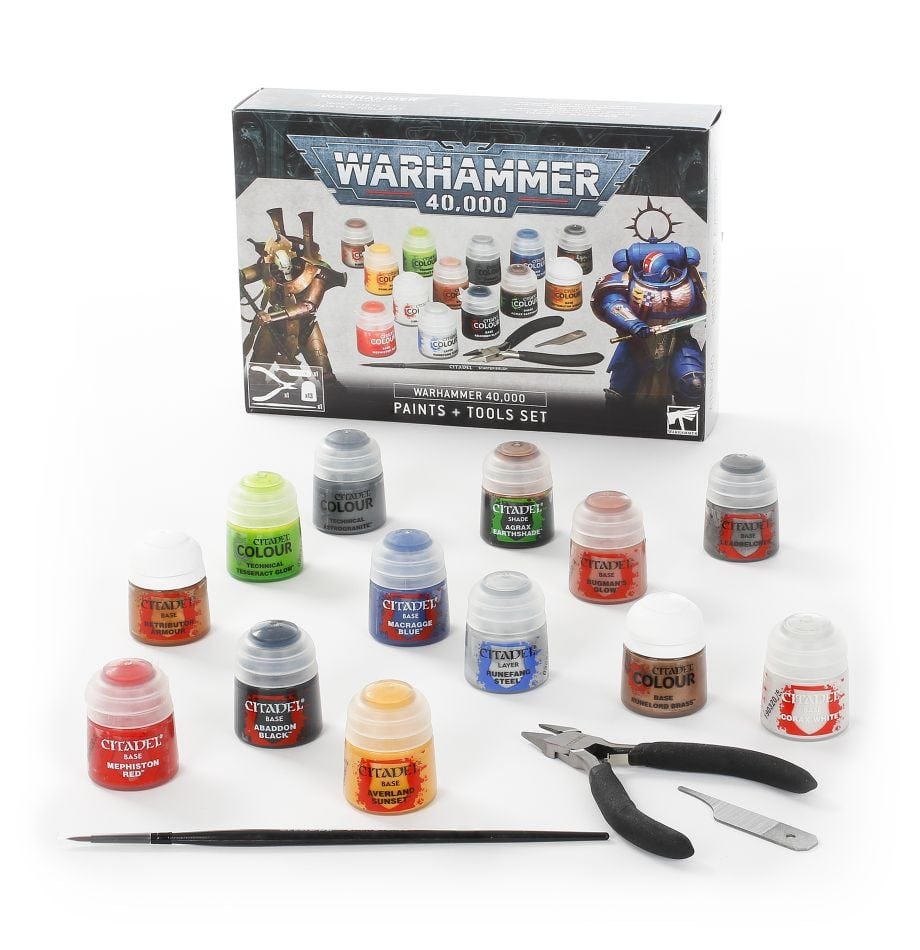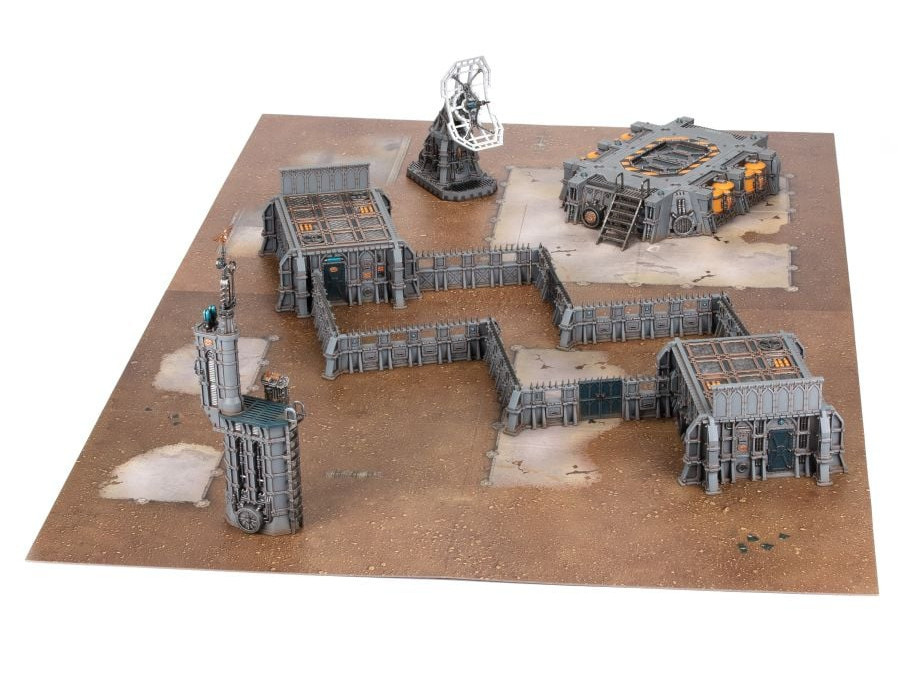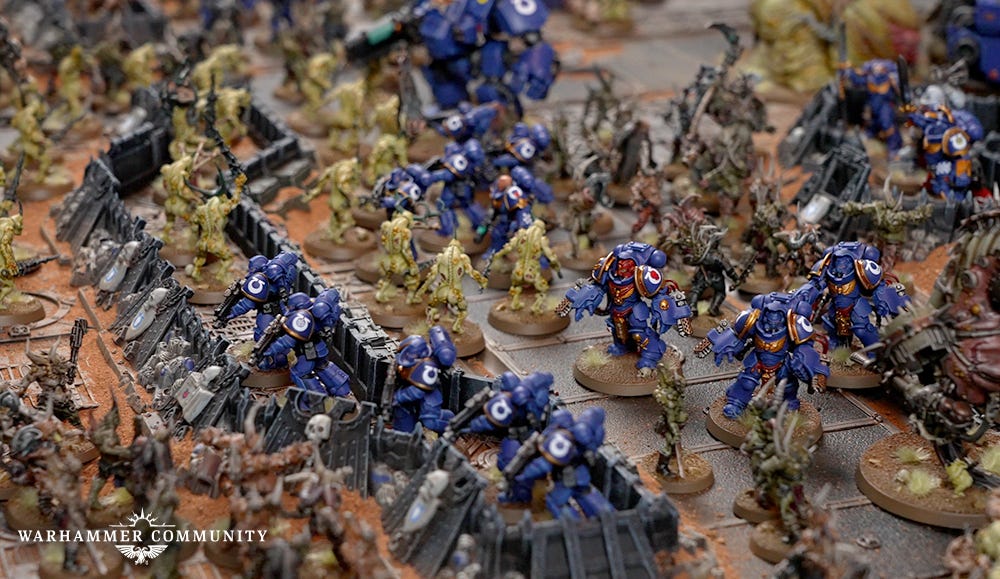PART I | PART II | PART III | PART IV | PART V
So you’ve looked at the twenty-plus factions of 40K, done some research on the lore, and/or decided that one faction looks really cool, and now you want to try the game. What do you do? Well, now you have to start buying minis and build an army for that faction. If the sheer number of faction choices is the first hurdle to getting into Warhammer 40K the game, then the second hurdle is price.
Most board games require a little investment. It’s not unusual to see large games with dozens of pieces selling for around a hundred dollars. Even tabletop RPGs usually require a buy-in of at least $60 to get you the basic rules.
40K’s buy-in is a little steeper.
The Rulebooks
Your first investments are the rulebooks: the “Core Book” for the universal rules and the codex belonging to your chosen faction. That will cost you a good $110 up front as of the time of this writing.
You can technically play a game of Warhammer 40K with only a handful of minis and a copy of the free rules available online, but you will still need access to the datasheets for your minis, which are only legally available via codex.
Your next step is to gather your minis. Armies are made up of units containing between one and a dozen models. Every unit has a point value. In order to enjoy a proper game of 40K, you need to assemble an army of at least 500 points.
How many points is each unit worth? Only the codex will tell you. And point values change all the time. This means that there is no way to know before committing to a faction how expensive that commitment is going to be. The internet can help, but the actual numbers are hidden behind the $50 pay-wall of your chosen codex.
If you are looking for the “cheapest” armies to build, then you counter-intuitively want to invest in a faction with the most expensive models. The cheapest factions to build are the Adeptus Custodes and the Knight factions (chaos and imperial). Each knight model can cost upwards of $170, but you only need one or two to meet that 500-point minimum. Games Workshop also sells “combat patrol” boxes for some factions that will instantly get you that 500 point minimum for $160.
Keep in mind, 500 points is the minimum starting point. Full games - including tournament play - require at least 1,000 points, meaning double the entry fee. The idea of The Hobby is to start you small, and then have you build on that over time.
The Paints
So now that you’ve bought the rulebooks and your first combat patrol, you may be out $270, but you’re ready to go, right? Wrong.
40K minis are not ready to play out of the box. They are delivered in pieces held by plastic sprues that you must then cut out and assemble yourself. This is the next major pillar of The Hobby: assembling the miniatures. A typical combat patrol will have 20-30 miniatures (assuming you didn’t go the way of the Imperial Knight), each of which you will have to assemble by hand.
Once you’ve assembled an army of plastic miniatures, are you ready to go now? Well, you COULD play with your dull monochrome miniatures, but you would be in the wrong. You should really paint those miniatures. This is considered the third pillar of “The Hobby.”
Painting may not be strictly necessary for playing the game of 40K, but it is required for tournament play, and you’re likely going to be called out at game stores for attempting to play with unpainted plastic. Don’t worry; you don’t need to paint them well.
So now you need to invest in miniature paints. You can invest in GW’s own Citadel paint line, which will cost you $5 per paint pot. These pots are meticulously designed to dry up and make mixing colors difficult. They are not my favorite. There are also Vallejo and Army Painter paints, which have the decency to be placed in dropper bottles so you can actually manage the amount of paint you use and mix colors with ease.
Then there are brushes. I have never found a brush that I couldn’t fray after the second or third use, so I can offer you no helpful information here. Just remember, miniatures are very very small, with a lot of detail, so you will want brushes with very small tips.
So how much you spend on paint will depend on how detailed you want your paint job. GW has a starting set (complete with tools for miniature assembly) for $35-45.
The Terrain
So now that you’ve dropped $300 or more and spent dozens of hours assembling and painting your miniatures, you are officially ready to play. Now you just need something to play on. Warhammer 40K is a tabletop game that requires the WHOLE tabletop to play (minimum playing space is 3’x4’). Playing on a flat plane without any cover would be boring, though, so you are expected to cover that play space with some kind of terrain.
You can make your own terrain out of cardboard and stacks of books if you’re tight on cash after dropping $300 on minis, or you can spend even more money on official plastic terrain that, like the minis, require assembly and painting. The results are often as beautiful as they are expensive.
Last of all, you have to find someone to play with. Unless you’ve brought a friend along on this journey and convinced them to pay the $300+ buy-in, your only real hope is to find a game at your friendly neighborhood game store.
The Headache
So in summary, if you are interested in playing a game of Warhammer 40K, you should expect to pay a minimum of $300 at the outset, spend hours assembling and painting miniatures, and only then are you ready to go out and find somewhere to play and someone to play with. Seems like a pretty steep buy-in for a game that you may be on the fence about.
Fortunately, there are other ways into the world of Warhammer 40K than the game. In the next part, we will explore the other, more wallet-friendly ways to engage with Warhammer 40K and The Hobby.










This is great stuff. I’m hooked!